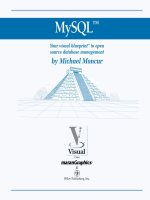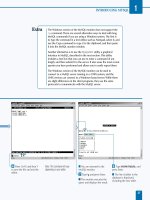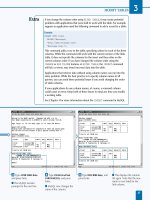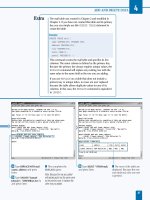C#Your visual blueprint for building .NET applications phần 5 pptx
Bạn đang xem bản rút gọn của tài liệu. Xem và tải ngay bản đầy đủ của tài liệu tại đây (1015.89 KB, 32 trang )
int
int Param1
™ Type the indexer
parameter name(s) in the
Parameter name field.
£ Add the name(s) to the
Parameter list field by
clicking the Add button.
¢ Click to select the indexer
modifier from the Indexer
modifiers area.
∞ Type a comment for your
indexer.
§ Click the Finish button.
■ The indexer code skeleton
appears in your class code so
you can edit it.
WORKING WITH TYPES AND INTERFACES
5
Properties and indexers have some similarities — the
most obvious is that all of the rules defined for the
properties get and set accessors also apply to the
indexer get and set accessors.
Although properties and indexers are related, you should
be aware of some significant differences:
• Visual C# identifies a property by its name and an
indexer by its signature.
• You can access a property with a simple name. You
must access an indexer through an element.
• A property can have a static object that does not
change. An indexer must contain instance information
generated by the class.
• The get accessor of a property has no additional
parameters. The get accessor of an indexer has the
same parameters as the indexer.
• The set accessor of a property contains the implicit
value parameter. The set accessor of an indexer has the
value parameter and the additional indexer parameters.
115
063601-X Ch05.F 10/18/01 11:59 AM Page 115
A
method is a piece of code that implements an action
that a class or object can perform. Methods appear
within a class and provide additional information that
classes cannot handle.
C# supports two types of methods: static and non-static. All
objects in a class can access the static methods in that class
without creating any instance of that class. Instances of a
class can only access non-static methods. For more
information on adding static and non-static methods, see
pages 6 to 13.
You can overload methods, which means that different
methods can have the same name as long as each separate
method has a unique signature. C# identifies a signature by
looking for specific method features including the method
name and the method parameters.
You can only add a method when you are editing a class.
When you program a method you can do so in one of two
ways: in code or by using the C# Method Wizard. The C#
Method Wizard contains fields with basic method
information that you can enter and choose from. Once you
finish entering information into the wizard, the basic
method code information appears in your code so you can
edit it.
VIEW INFORMATION ABOUT METHODS
116
VIEW INFORMATION ABOUT METHODS
C#
Index Crtl+Alt+F2
⁄ Click Start ➪ Programs ➪
Microsoft Visual Studio .NET
7.0 ➪ Microsoft Visual Studio
.NET 7.0.
■ The Start page appears. ¤ Click Help. ‹ Click Index.
073601-X Ch06.F 10/18/01 11:59 AM Page 116
When you add a new method, you can have
several methods with the same name with
different signatures in the same class. However, if
you try to add a method and another class type
such as an interface with the same name, the
MDE window would register an error and the
compiler would not be able to run the program.
If you have the same name for the method and
interface but the method and interface were in
separate classes, then C# would have no
problem.
Though C# looks for the module name and the
formal parameter list when determining a module
signature, it does not look for the return type or the
names of the parameters. So if you receive an error
from the MDE window about signatures, check to
see that your module names and lists are different
for each module.
PROGRAMMING METHODS AND EVENTS
6
117
adding in C# adding in C#
methods, adding in
■ The Index window appears.
› Type methods in the Look
for field.
ˇ Click the adding in C#
entry in the Index list box.
■ The C# Add Method
Wizard appears so you can
learn about adding methods.
073601-X Ch06.F 10/18/01 12:00 PM Page 117
Visual C# Projects
Console
Application
⁄ Click Start ➪ Programs ➪
Microsoft Visual Studio .NET
7.0 ➪ Microsoft Visual Studio
.NET 7.0.
■ The Start page appears.
¤ Click New Project.
■ The New Project window
appears.
‹ Click the Console
Application icon in the
Templates pane.
› Type a name for the file.
ˇ Click OK.
A
s with a property and an indexer, C# gives you two
ways to add a method. If you like the step-by-step
functionality provided by a wizard, the C# Add
Method Wizard lets you add a method automatically. You
can also add a method in code.
When you add a method in code you start with the method
keyword. You can add information that precedes the
keyword: whether the method is static or non-static (the
default is non-static) and whether the method contains a
void type. The void type renders the method invisible
where it takes on no parameters and returns no values.
After you enter the method keyword, you can enter the
optional method declarations. These declarations include
various attributes, method modifiers, the return type, and
then the name of the method itself. Then you begin to add
the information within your method.
Attributes include names that you can enter in your class
and refer to in your method. An attribute is a good way to
identify information that you want to include in your class
such as your company Web site. The method modifiers help
determine the access to your method from your class and
other code in your project.
ADD A METHOD
C#
118
ADD A METHOD
073601-X Ch06.F 10/18/01 12:00 PM Page 118
Add Method . . .
Class View - M. . .
Class1
Public
Void
int
Add
Method
{}Method
Á Click the Class View tab.
‡ Click the plus sign ( )
next to the Method name.
° Click the plus sign ( )
next to the {} Method name.
· Right-click the class name
to open the pop-up menu.
‚ Click Add ➪ Add Method.
■ The C# Method Wizard
window appears.
PROGRAMMING METHODS AND EVENTS
6
You use the return keyword in all methods except one: the
void type. When you specify the void method type, you do
not need to include the return keyword because the return
type is automatically void.
119
TYPE THIS:
using System;
class VoidTest
{
public static void Main()
{
int diameter = 25;
Console.WriteLine("The diameter is {0}", diameter);
}
}
RESULT:
The diameter is 25
CONTINUED
073601-X Ch06.F 10/18/01 12:00 PM Page 119
void
int
void
Int Parameter1
int
— Type the method name in
the Method name field.
Note: The Method signature field at
the bottom reflects the changes to
the method code as you type
information into the wizard fields.
± Type the parameter name
in the Parameter name field.
¡ Click Add.
■ The added parameter
name appears in the
Parameter list field.
A
fter you include the attributes and method access
modifiers, you can further define your method using
several different modifiers.
If your method resides in an inheriting class and you also
have a modifier in your base class, you can disregard the
method in the base class by adding the new keyword. Using
the new keyword in your method effectively hides the base
class method so your class only pays attention to the
method in its class.
You can determine if the method will have the static,
virtual, override, abstract, or extern status. A static method
lets all objects in its class access it. You can use a virtual
method in an inheriting class; a virtual method checks to
see if any methods in any related class must override that
method. An override method tells that method to override
any methods in any related classes. The abstract method
introduces a new virtual method but acts as a placeholder
for a different method in a related class that will override
the abstract method. The extern modifier lets you create
an external method.
Once you add the modifier you can determine the return
type and then enter the name of the method. After you add
the method name you can begin work on the body of your
method.
ADD A METHOD
C#
120
ADD A METHOD (CONTINUED)
073601-X Ch06.F 10/18/01 12:00 PM Page 120
void
int
int Parameter1
™ Click to select a method
modifier from the Method
modifiers check box area.
£ Type a comment in the
Comment field.
¢ Click Finish.
■ The method code appears
in the parent window.
PROGRAMMING METHODS AND EVENTS
6
C# lets you return multiple values from one
method by using the out parameter.
121
TYPE THIS:
using System;
public class OutTest
{
public static int Output(out int a)
{
a = 25;
return 0;
}
public static void Main()
{
int a;
Console.WriteLine(Output(out a));
Console.WriteLine(a);
}
}
RESULT:
0
25
073601-X Ch06.F 10/18/01 12:00 PM Page 121
Visual C# Projects
Console
Application
⁄ Click Start ➪ Programs ➪
Microsoft Visual Studio .NET
7.0 ➪ Microsoft Visual Studio
.NET 7.0.
■ The Start page appears.
¤ Click New Project.
■ The New Project
window appears.
‹ Click the Console
Application icon in the
Templates pane.
› Type a name for the file.
ˇ Click OK.
A
static method maintains its information regardless of
how many class instances are created; you can use
static methods for maintaining a value such as the
boiling temperature of water. Like classes, methods are
either static or instance members of the class. A static
method contains information that will remain constant so
the class can use it repeatedly. This is useful when you want
to make calculations in your class with a value that is always
constant.
You must explicitly include the static option before typing
in the method keyword in your code. If you do not, then C#
will automatically consider the method to be non-static.
This chapter discusses non-static methods in greater detail
later on.
If you declare a static modifier with your method, then you
cannot also include a virtual, abstract, or override modifier.
If you try to, the MDE window will point out the error and
your project will not compile. The static modifier remains
with that class and only with that class — it does not rely on
any methods in any other inheriting or base class. Because
virtual, abstract, and override modifiers deal with inheriting
classes, they do not apply to static modifiers.
You cannot access static members through object instances
that occur when you run your project. That is what non-
static methods are for. You can access static methods
through both value and reference types.
ADD STATIC METHODS
C#
122
ADD STATIC METHODS
073601-X Ch06.F 10/18/01 12:00 PM Page 122
Add Method
Add
Class1
int
void
StaticMethod
Á Click the Class View tab.
‡ Click the plus sign ( )
next to the Method name.
° Click the plus sign ( )
next to the {} Method name.
· Right-click the class
name.
‚ Click Add ➪ Add Method.
■ The C# Method Wizard
appears.
— Type the method name in
the Method name field.
Note: The Method signature field at
the bottom reflects the changes to
the method code as you type
information into the wizard fields.
PROGRAMMING METHODS AND EVENTS
6
If you need to return more than one variable from
your static method, you can do so using the params
keyword.
123
TYPE THIS:
using System;
public class Params
{
public static void Parameter(params int[] list)
{
for ( int x = 0 ; x < list.Length ; x++
)
Console.WriteLine(list[x]);
Console.WriteLine();
}
public static void Main()
{
Parameter(10, 15, 20);
}
}
RESULT:
10
15
20
CONTINUED
073601-X Ch06.F 10/18/01 12:00 PM Page 123
void
Class1.cs
int
± Type the parameter name
in the Parameter name field.
¡ Click Add.
■ The added parameter
name appears in the
Parameter list field.
™ Click to select a method
modifier from the Method
modifiers check box area.
£ Click Finish.
■ The static method code
appears in the parent
window.
¢ Move the static
method code above the Main
method code.
∞ Type the Record class
code that establishes
variables and static methods
for adding to the number of
records.
C
# uses simple names for accessing many different
elements in a C# project, and methods are no
different. However, if you have a static method then
how you program static methods and other static
information in your method determines if you can use
simple names or not.
Simple names for a variable can be just one letter, such as x.
When you declare variables and associate them with value
types, the methods you include those declarations in
determine whether your program can process those
variables. For example, you can declare two variables of
integers with the simple names a and b, with a declared as a
non-static member and b declared as a static member.
If you place the two variables in a non-static method and
evaluate them later in your class, you will have no trouble
with your evaluation. However, if you put those two
variables in a static method you will only be able to
evaluate the static variable b because a static method
cannot access a non-static variable.
If you decide to plunge ahead anyway and try to evaluate a
non-static variable in a static method, you will find that the
MDE window will protest that action and your program will
not compile until you fix the problem.
ADD STATIC METHODS
C#
124
ADD STATIC METHODS (CONTINUED)
073601-X Ch06.F 10/18/01 12:00 PM Page 124
§ Type the Main method
that lets the user input values
and outputs the results.
¶ Press the F5 key.
■ Type information at the
prompts and the output
appears.
• Save the program as the
filename.
PROGRAMMING METHODS AND EVENTS
6
You can reference a static method in what Visual
Studio .NET refers to as a member-access
format. The member-access format contains the
full version of the type and its associated
identifier. The member-access format comes in
the form of the type, a period, and then the
identifier. For example, you can have the
member access type int.number.
C# and the Visual Studio .NET suite do not force
you to use the member-access format because
many of the access types have aliases that C#
refers to. If you reference your static method (or
any other static member) in member-access form
you must do so in the form E.M. The E must
stand for the type that your method uses, not the
object. The M stands for the type identifier. For
example, if your method is of the type integer
with the name NumberOne, then the member
access form is int.NumberOne.
125
073601-X Ch06.F 10/18/01 12:00 PM Page 125
Visual C# Projects
Console
Applications
⁄ Click Start ➪ Programs ➪
Microsoft Visual Studio .NET
7.0 ➪ Microsoft Visual Studio
.NET 7.0.
■ The Start page appears.
¤ Click New Project.
■ The New Project
window appears.
‹ Click the Console
Application icon in the
Templates pane.
› Type a name for the file.
ˇ Click OK.
T
he non-static status is the default for all methods.
Non-static methods, also called instance methods, rely
on an instance of the class — that is, the non-static
method relies on the information it receives from an object
generated by the class. Once the non-static method
receives that object it provides the object with its
implementation instructions and sends the object back out
into the class for further processing.
The non-static method is best if you know that the class will
generate an object for the method. If you create a method
in an inherited class, then the non-static method is the only
choice. A static method belongs to its class, but a non-static
method can take objects from inheriting classes. You can
also set non-static methods to override or be overridden by
other non-static methods in other inherited classes in your
class family or from the base class.
Your non-static method does not accept objects
automatically. You must tell the method that you want to
accept the value by using the this keyword. When you use
the keyword this in your method, the referenced object
receives a type that matches the object type and a value
that acts as a reference to the object.
INCLUDE NON-STATIC METHODS
C#
126
INCLUDE NON-STATIC METHODS
073601-X Ch06.F 10/18/01 12:00 PM Page 126
Add Method
Class View - N
Add
Class1
int
void
Á Click the Class View tab.
‡ Click the plus sign ( )
next to the Method name.
° Click the plus sign ( )
next to the {} Method name.
· Right-click the
class name.
‚ Click Add ➪ Add Method.
■ The C# Method
Wizard appears.
— Type the method name in
the Method name field.
Note: The Method signature field at
the bottom reflects the changes to
the method code as you type
information into the wizard fields.
PROGRAMMING METHODS AND EVENTS
6
You can reference a non-static method with the
member-access format so you can point directly to the
member you want the method to call.
127
TYPE THIS:
using System;
public class Name {
public string first;
public string last;public Person () { }
public Person (string first, string last) {
this.first = first;
this.last = last;
}
class Main: Person {
public static void Main() {
Console.Write("First name? ");
String first = Console.ReadLine(); //accepts input
Person a = new Person (name, id);
Console.WriteLine("First name: {0}", a.first);
}
}
RESULT:
First name? John
First name: John
CONTINUED
073601-X Ch06.F 10/18/01 12:00 PM Page 127
int
void
± Click to select the Virtual
method modifier from the
Method modifiers check box
area.
¡ Click Finish. ■ The method code appears
in the parent window.
™ Type code that establishes
the First class and move
the method code within the
First class.
£ Type the code for the
One method.
¢ Type code and an
override method in the
Second class.
W
hen the non-static method processes the instance
of a class, C# creates a copy of all instance (that is,
object) fields for the method to process. This
ensures that a copy of the instance remains in the class
while your class is being instructed by the non-static
method. Once the object leaves the non-static method, the
method-trained copy replaces the original that was in the
class.
The earlier discussion in this chapter about static methods
included information about simple names and how the
declaration of those names can affect processing in a static
method. With non-static methods the same rules apply.
If you try to evaluate a static variable in a non-static
method, you will receive an error and the MDE window
will prohibit you from compiling your program.
If you have a non-static method that another method in
another inheriting class can override, be sure that your
overriding non-static method can process the variables in
your class correctly. If you do not, you may encounter
processing errors because the new, overriding method may
not be able to process all the variables in your class. The
same holds true if you override a non-static method in
another inheriting class.
INCLUDE NON-STATIC METHODS
C#
128
INCLUDE NON-STATIC METHODS (CONTINUED)
073601-X Ch06.F 10/18/01 12:00 PM Page 128
∞ Rename the Class1 class
as Output.
§ Type the Main method
that outputs the values.
¶ Press the F5 key.
■ The Second class
overrides the First class
and produces two output
lines of Second.One.
• Save the program as the
filename.
PROGRAMMING METHODS AND EVENTS
6
You can represent a class object in the member-
access format as well for precise representation
of your object. Though the member-access E.M
format is the same as with static methods, the E
cannot represent a type. Instead, the E must
represent the class instance. Usually the
member-access format does not include the
identifier signified by M because the instance
expression signified by E is all the information
needed.
Another reason for using the member-access
format is that you can perform a member
lookup. A member lookup evaluates simple-
name or member-access forms in an expression
or statement.
129
073601-X Ch06.F 10/18/01 12:00 PM Page 129
Visual C# Projects
Console
Applications
⁄ Click Start ➪ Programs ➪
Microsoft Visual Studio .NET
7.0 ➪ Microsoft Visual Studio
.NET 7.0.
■ The Start page appears.
¤ Click New Project.
■ The New Project
window appears.
‹ Click the Console
Application icon in the
Templates pane.
› Type a name for the file.
ˇ Click OK.
D
elegates act like pointers that you find in other
languages such as C++, but delegates go several
steps further in C#. Delegates provide object-
oriented pointers to methods from other points in your
project. This approach makes it easy for methods
throughout your program to retrieve information from one
source without having to enter that information repeatedly.
Delegates provide two key benefits. Delegates act as a
central point where all pieces of your code that need
objects refer to a specific method. It is quite inconvenient
to have to write static methods for many different classes.
It is also inconvenient to refer to the same class for the
same method, and that approach can also slow your project
down when it runs. It is much more efficient to have one or
a few delegates that can handle method operations for your
entire project.
The second benefit of delegates is anonymity. The delegate
does not care about what the method includes — whether
it be static or non-static, what accessibility the method has,
or any other information. The only thing the delegate cares
about is if the method that it is looking for has the same
signature as the delegate.
ENTER DELEGATES
C#
130
ENTER DELEGATES
073601-X Ch06.F 10/18/01 12:00 PM Page 130
Á Type the Main method
code that outputs the values.
‡ Type the code for the
methods that specify and
output the delegate value.
° Press the F5 key.
■ The delegate output appears.
· Save the program as the
filename.
PROGRAMMING METHODS AND EVENTS
6
You can combine existing delegates into a multi-cast
delegate.
131
TYPE THIS:
using System;
delegate void Del1(string x)
class Class1
{
public static void On(string x)
{
Console.WriteLine("Switch goes on.", x);
}
public static void Off(string x)
{
Console.WriteLine("Switch goes off.", x);
}
public static void Main();
{
Del1 a, b, c;
a = new Del1(On);
b = new Del1(Off);
c = a + b;
Console.WriteLine("The two switch states:");
c;
}
}
RESULT:
The two switch
states:
Switch goes on.
Switch goes off.
073601-X Ch06.F 10/18/01 12:00 PM Page 131
Visual C# Projects
Console
Applications
⁄ Click Start ➪ Programs ➪
Microsoft Visual Studio .NET
7.0 ➪ Microsoft Visual
Studio .NET 7.0.
■ The Start page appears.
¤ Click New Project.
■ The New Project
window appears.
‹ Click the Console
Application icon in the
Templates pane.
› Type a name for the file.
ˇ Click OK.
Á Type the code that
establishes your event
delegate, interface, and class.
I
n object-oriented programming, an event lets clients of
that class — clients can include delegates, other classes,
methods, and indexers — know about something that
happens to an object in a class. That something that
happens is of great interest to the clients in the class and so
the event lets those clients know about it and act
accordingly.
By acting accordingly, the clients give the class delegates so
the delegates can retrain those objects using the modules
called by those delegates. Once the appropriate module
retrains the changed object to behave properly, the object
goes back to the class for further processing.
When you declare an event inside of a class you must
declare the delegate inside the event. The class that the
event resides in is the only class that calls the event. When
the class calls the event, the class checks to see if a client
has hooked up a delegate to the event, and if that is true
then the class processes the event.
The previous task mentioned that C# declares events using
delegates. If you have come to this task wanting to learn
about events but you have not learned about delegates yet,
skip back four pages and read about delegates before you
continue on.
PROGRAM EVENTS
C#
132
PROGRAM EVENTS
073601-X Ch06.F 10/18/01 12:00 PM Page 132
‡ Type the code for the
Output class that outputs
the string when the event
fires.
° Press the F5 key.
■ The string appears on the
screen when the event fires.
· Save the program as the
filename.
PROGRAMMING METHODS AND EVENTS
6
The facts that events can only be called from the
classes they reside in and that classes can be
inherited poses an interesting problem. C# does
not let you invoke events in a base class from an
inheriting class. This seems to defeat the purpose
of having a class inherit all information from your
base class. However, C# does offer a workaround
to this problem.
C# can have an inheriting class call a base class
event by creating a protected invoking method
within the event. This method invokes the base
class event and the project passes along the
information from that base class event to the rest
of the event. If you would rather not have the base
class send its events, you can have this protected
invoking method as a virtual method. An
overriding method in an inheriting class can then
take over from the virtual method and shut down
the base class events.
133
073601-X Ch06.F 10/18/01 12:00 PM Page 133
Visual C# Projects
Form1.cs
Console
Applications
⁄ Click Start ➪ Programs ➪
Microsoft Visual Studio .NET
7.0 ➪ Microsoft Visual Studio
.NET 7.0.
■ The Start page appears.
¤ Click New Project.
■ The New Project
window appears.
‹ Click the Windows
Application icon in the
Templates pane.
› Type a name for the file.
ˇ Click OK.
■ A blank form appears in
the parent window.
Á Access the Toolbox by
pressing Ctrl+Alt+X.
■ The toolbox window
appears with the Windows
Forms tools open.
‡ Click the Button entry.
° Click and drag the outline
of the button in the form.
C
# lets you bind an event and a method in the form of
an event handler. When your program invokes an
event, then the event handler calls the method
associated with that event.
Event handlers are used with Windows forms in C# because
they are well-suited for the events, such as a button click
and the methods that follow, such as a window opening.
The event handler code contains two parameters for
handling the event. The sender parameter references the
argument that sent the event. The event object parameter
sends an object specific to the handled event.
When you create an event handler, the calling event will
produce a different object parameter type. There are some
object parameter types with some built-in events in Visual
Studio .NET such as mouse events.
These parameters help determine other information that is
pertinent to a Windows form or any other graphical user
interface that you want to program. For example, you may
need information about where the mouse pointer is, where
windows are on the screen, or where data is when you
drag-and-drop.
ADD AN EVENT-HANDLING METHOD
C#
134
ADD AN EVENT HANDLING METHOD
073601-X Ch06.F 10/18/01 12:00 PM Page 134
· Click the Events button in
the Properties window.
‚ Click the field to the right
of the Click1 entry.
— Type the event handler
name.
■ The event handler skeleton
code appears so you can type
in the event handler.
± Save the program as the
filename.
Properties
Click
PROGRAMMING METHODS AND EVENTS
6
You can create an event-handling method within code.
Event-handling methods are always private and no matter
what event-handling method you want to add, such as a
mouse button click, the method arguments remain the
same.
135
TYPE THIS:
private void Event1(object sender, System.EventArgs e)
{
button1.Click += new EventHandler(button1_Click);
}
RESULT:
When you run your program and the form appears, the
form will click when you press down with the left mouse
button.
073601-X Ch06.F 10/18/01 12:00 PM Page 135
A
n array is a programming staple used in many
different languages; arrays act as containers for
elements in the same data type. For example, an
array can contain a group of integers. C# treats arrays as
objects that the program accesses through a reference
variable.
You enter arrays using two square brackets ([]) after the
array type and then enter the array identifier. C# indexes
arrays starting with zero. For example, if you create an array
that has ten elements in it, the array identifies the elements
in the array from 0 through 9.
C# supports three different types of arrays: single-
dimensional arrays, multidimensional (or rectangular)
arrays, and array-of-arrays (jagged arrays).
A single-dimensional array is the simplest type. You can use
single-dimensional arrays for storing simple lists like your
friends’ names or a set of numbers.
A multidimensional or rectangular array lets you store data
information by x and y types much as you do when you
store data in a spreadsheet column and row.
An array-of-arrays or jagged array lets you nest an array
within one or more arrays so an element in one array can
access elements in its partner arrays.
This chapter takes you through the different arrays and how
to use each array type properly.
VIEW INFORMATION ABOUT ARRAYS
136
VIEW INFORMATION ABOUT ARRAYS
C#
Properties
⁄ Click Start ➪ Programs ➪
Microsoft Visual Studio .NET
7.0 ➪ Microsoft Visual
Studio .NET 7.0.
■ The Start page appears. ¤ Click Help. ‹ Click Index.
083601-X Ch07.F 10/18/01 12:00 PM Page 136
Several array declaration differences exist between C#,
C/C++, and Java. The differences are more pronounced
between C# and C/C++. The differences (and similarities)
include:
• Declaring an array is the same in Java as it is in C#; you
activate an array by including the new operator.
• You cannot place the bracket after the identifier as you
can in C or C++. If you are an experienced C or C++
programmer, take care to ensure that your brackets
appear after the type.
• The array is not part of its type as it is in C and C++.
This feature lets you assign as many objects of a type,
such as byte to an array no matter how long the array is.
• When you initialize an array, you include the array
elements without entering the new int [] argument as
you do in Java.
USING ARRAYS
7
137
Index
■ The Index window
appears.
Note: Close the Properties window
by clicking at the right side of
the Properties window title bar.
› Type arrays in the Look for
field.
ˇ Click to select Visual
C# in the Filtered by drop-
down menu.
Á Click C# under the arrays
topic list.
■ The Arrays Tutorial appears
in the parent window.
083601-X Ch07.F 10/18/01 12:00 PM Page 137
Properties
⁄ Click Start ➪ Programs ➪
Microsoft Visual Studio .NET
7.0 ➪ Microsoft Visual
Studio .NET 7.0.
■ The Start page appears.
¤ Click New Project.
■ The New Project window
appears.
‹ Click the Console
Application icon in the
Templates pane.
› Type a name for the file.
ˇ Click OK.
S
ingle-dimensional arrays let you define a set of
variables and store them in one block of memory for
easy retrieval. C# single-dimensional arrays can
include defined sets of data. For example, you can enter a
set of numbers or a set of string values such as the number
of months in a year. You can use any value type as part of
your array including integral, floating point, decimal,
Boolean, struct, and enumeration.
After you declare your array, you must initialize it by using
the new operator. When you initialize the array, you can
give the array specific values such as numbers or specify the
maximum number of elements in the array.
You give the array specific values as you do in C, C++, and
Java — placing the values in curly braces at the end of the
array argument. If you specify the maximum number of
elements in an array instead, C# automatically assigns the
first element in your array the number zero. For example,
an array with six elements will be numbered 0 through 5.
Accessing an array in C# is very similar to what you find in C
and C++. For example, you can create an integer array, then
assign an integer to a particular location in that array.
ENTER SINGLE-DIMENSIONAL ARRAYS
C#
138
ENTER SINGLE-DIMENSIONAL ARRAYS
083601-X Ch07.F 10/18/01 12:00 PM Page 138
Á Type the code that
outputs the opening string
and establishes the array in
the Main method.
‡ Type the code that
outputs the array by iterating
through each element using
the foreach statement.
° Run the program by
pressing the F5 key.
■ The prime number array
appears on the screen.
· Save the program as the
filename.
USING ARRAYS
7
You can omit optional parts of the single-dimensional array
argument. One way is to omit the size of the array.
int[] values = new int[] {1, 2, 3, 5, 7, 11};
string[] letters = new string[] {"A", "B", "C"};
Another way is to omit the new statement altogether.
int[] values = {1, 2, 3, 5, 7, 11};
string[] letters = {"A", "B", "C"};
139
083601-X Ch07.F 10/18/01 12:00 PM Page 139









